North America is home to multiple species of green moths. Some are widely common with widespread presence while others are only found in Southern states.
Green moths come in different sizes. With a minimum wingspan of just 10mm, these colorful moths are also found in species that have a wingspan of more than 50mm.
The green coloring of the moths varies from pale green to dark green. Emerald green moths are also highly common.
The following species of green moths are prevalent in North America.
Table of Contents
1. North American Luna Moth
North American Luna moths (Actias luna) are a common native species of green moths. The species has all-green coloring.
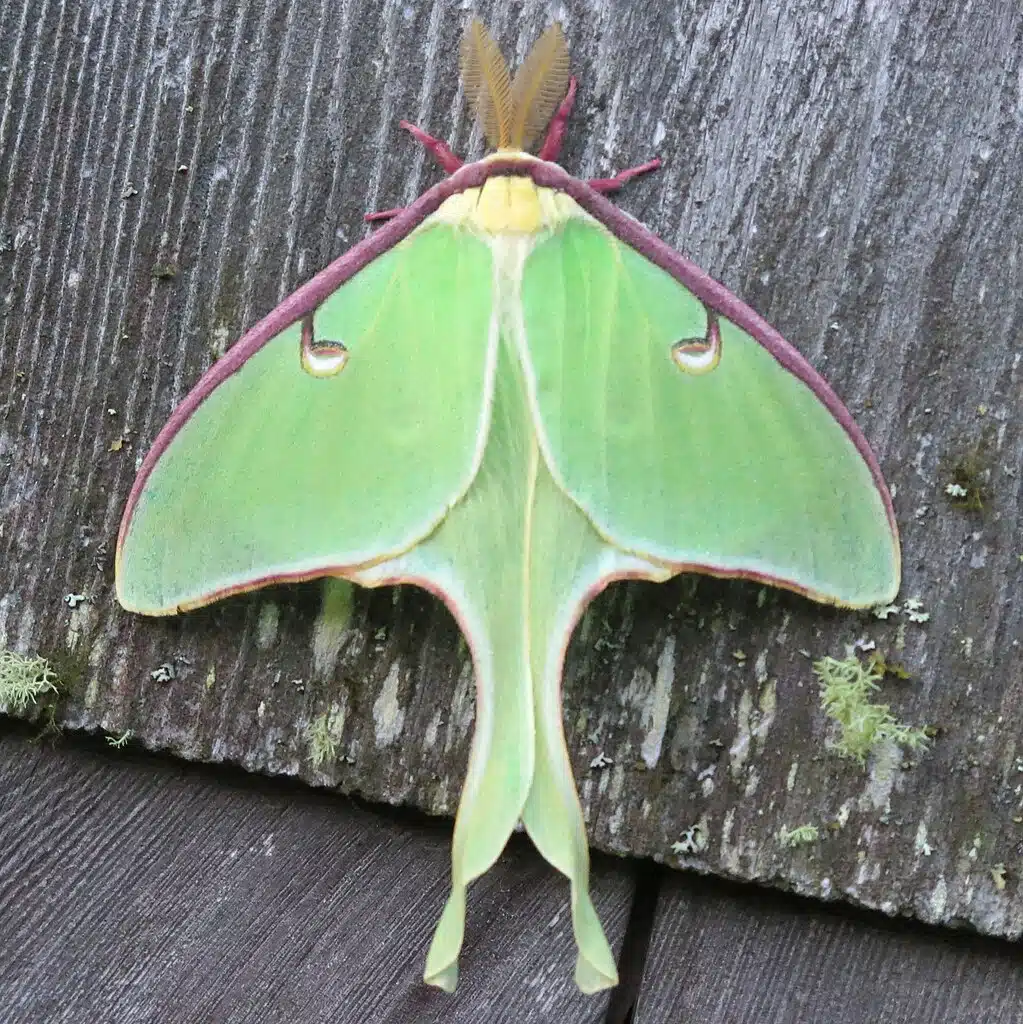
North American Luna moth appears in one brood in Northern states and multiple broods in Southern states.
Light green wings with gray or yellow eyespots are specific to this species.
Long green tails are also seen on the North American Luna moth.
This family of moths is seen on various plant hosts, mainly those with broad green leaves.
The North American Luna caterpillar is also mostly green, similar to the adult moth.
Caterpillars of the species have a green base color with yellow dots and short bristle-like black hairs.
2. Pale Beauty
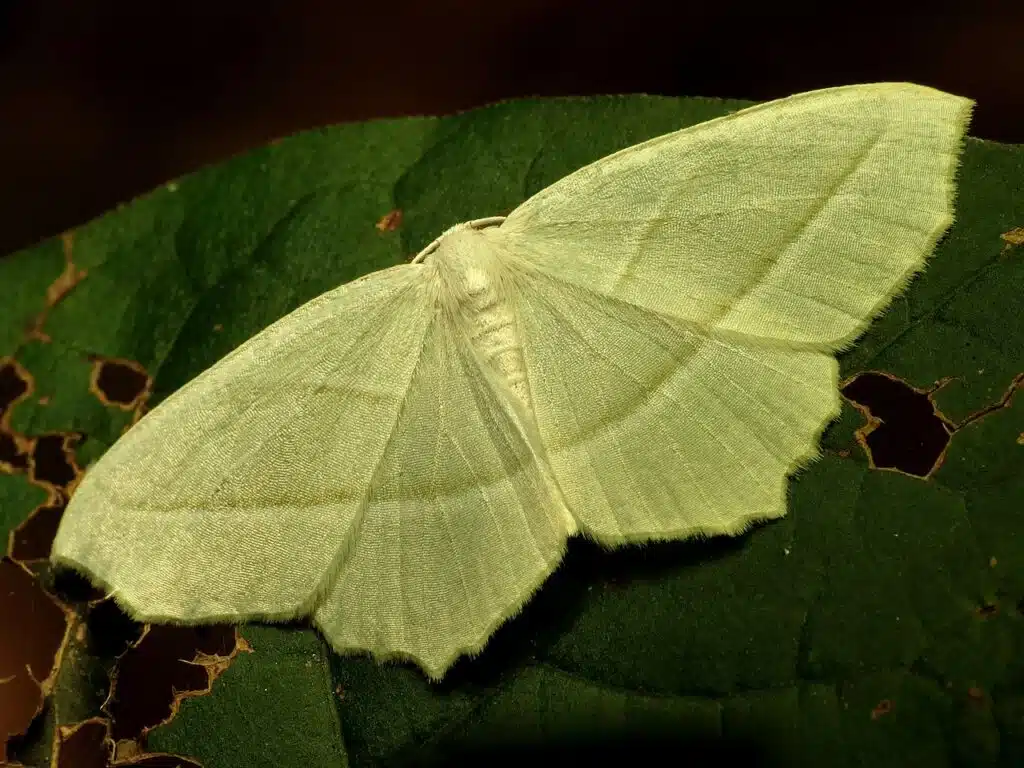
Pale Beauty moths (Campaea perlata) get their name from their pale green-gray color.
The species has a pale green color which aids them to remain undetected on their host’s trees.
The wingspan is highly variable in Pale Beauty moths. It can measure anywhere between 21 and 50mm.
Pale Beauty moths live in North America in an expansive territory from Alaska to Florida.
The species is mostly found in woodlands where its caterpillars feed on coniferous tree leaves.
Ash, fir, and elm are just a few host trees of the Pale Beauty caterpillar.
Adults may also be seen feeding on nectar such as blueberry nectar.
3. Wavy-lined Emerald
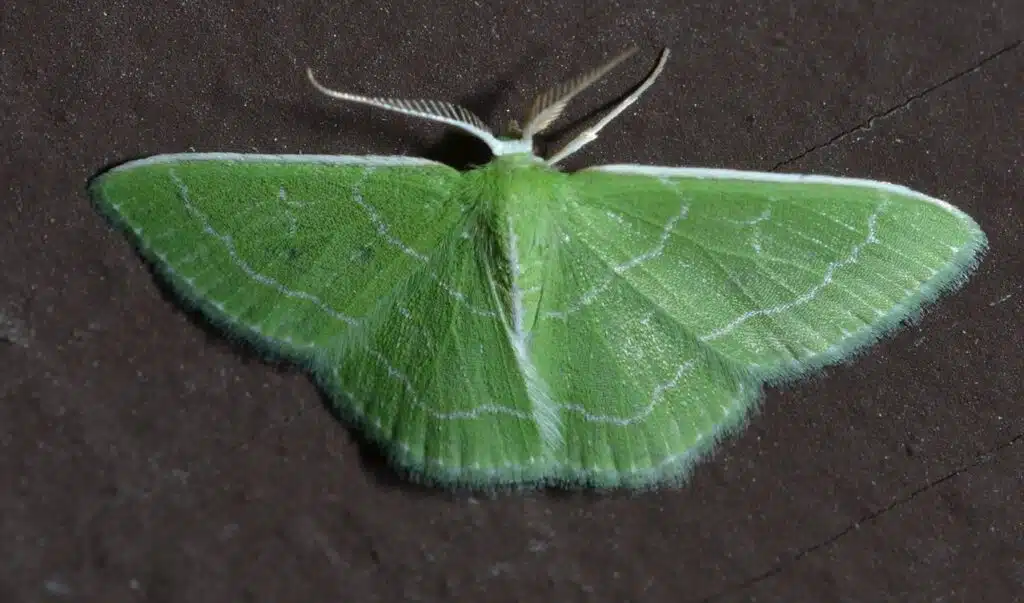
The Wavy-lined Emerald moth (Synchlora aerata) gets its name from the gray-white lines seen across its wings.
Green is the base color of the species. Emerald green is specific to the moth, as the name of the species suggests.
Most common in North America, the moth is not limited to a single host species, like other moths.
It bites the leaves of multiple plants and includes asters, goldenrods, and yarrows.
Part of the Geometridae family of moths and butterflies, the Wavy-lined Emerald is among the first species to be noted in North America.
4. Blackberry Looper Moth
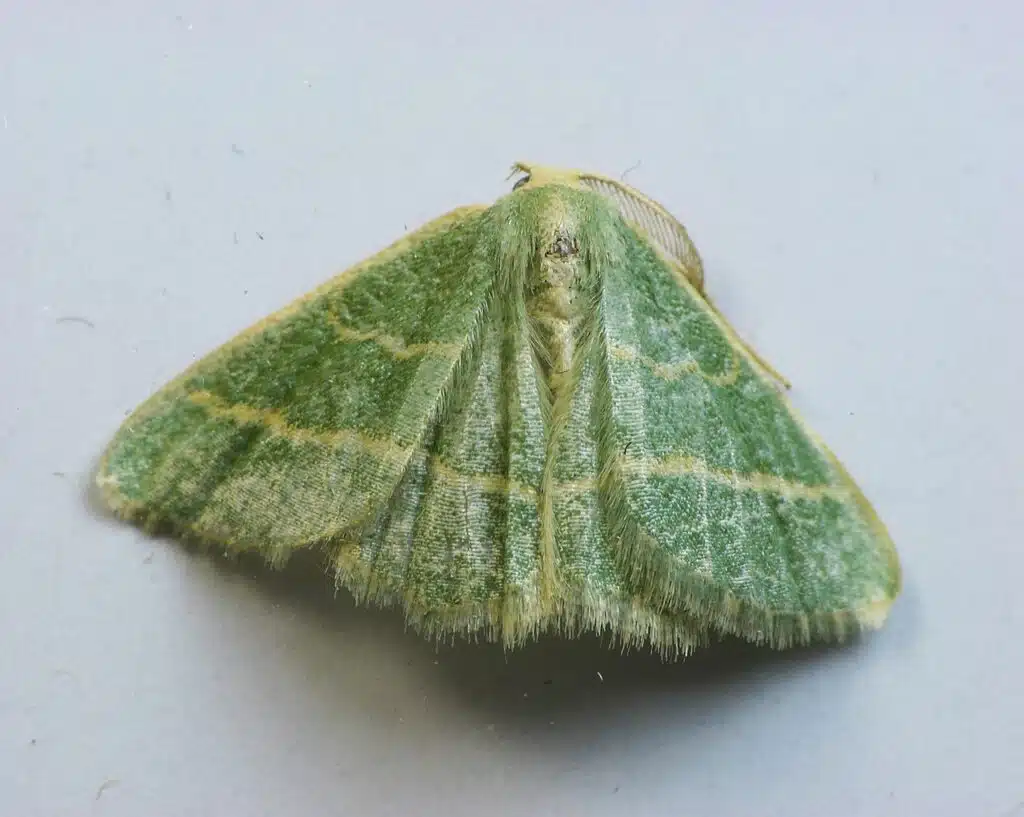
Blackberry Looper moths (Chlorochlamys chloroleucaria) are highly similar to Wavy-lined Emeralds. Both these species have an emerald green color with white or off-white lines and stripes.
The wingspan of the species is reduced compared to other North American native species. Blackberry Looper moths grow to various sizes and never measure more than 23mm.
The Blackberry Looper stands out with short bright stripes across its emerald green body as well.
This species bears the name blackberry but only the larvae of the family are known for eating blackberries.
Adults mostly feed on plants. As the Wavy-lined Emeralds, adult Blackberry Looper moths feed on a wider range of plants.
Asters, ambrosias, and yarrows are among the most common plants these moths consume.
5. Southern Emerald
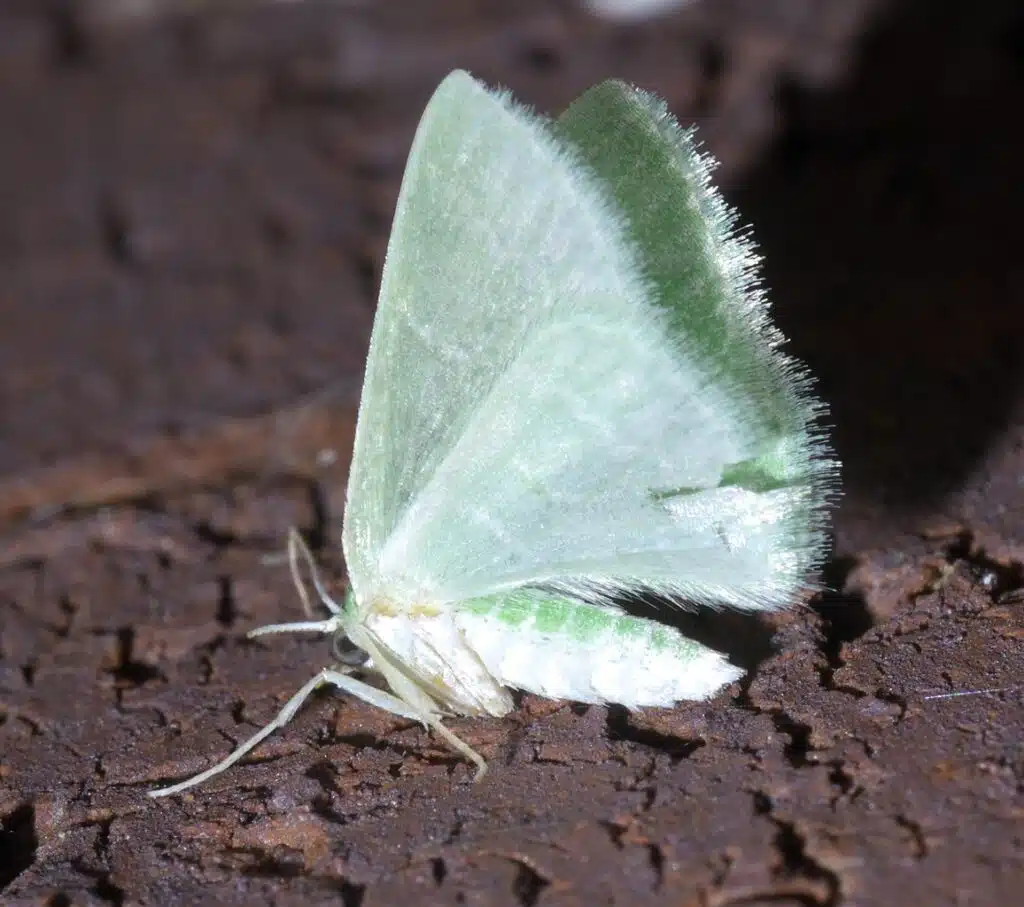
Southern Emerald moths (Synchlora frondaria) are only found in Southern US territories and further South in Mexico and The Caribbean.
This species of moth has the same emerald green color as the Emerald genus. Its wings show multiple white stripes and lines as well as white veins and short white hairs across the margins.
The species is found in different climates from arid habitats to crops and even suburban areas.
Many Sothern Emerald moths are found around sunflower crops. Sunflowers are the hosts of their caterpillars which feed on the leaves, stems, and roots of sunflowers.
6. Red-fringed Emerald
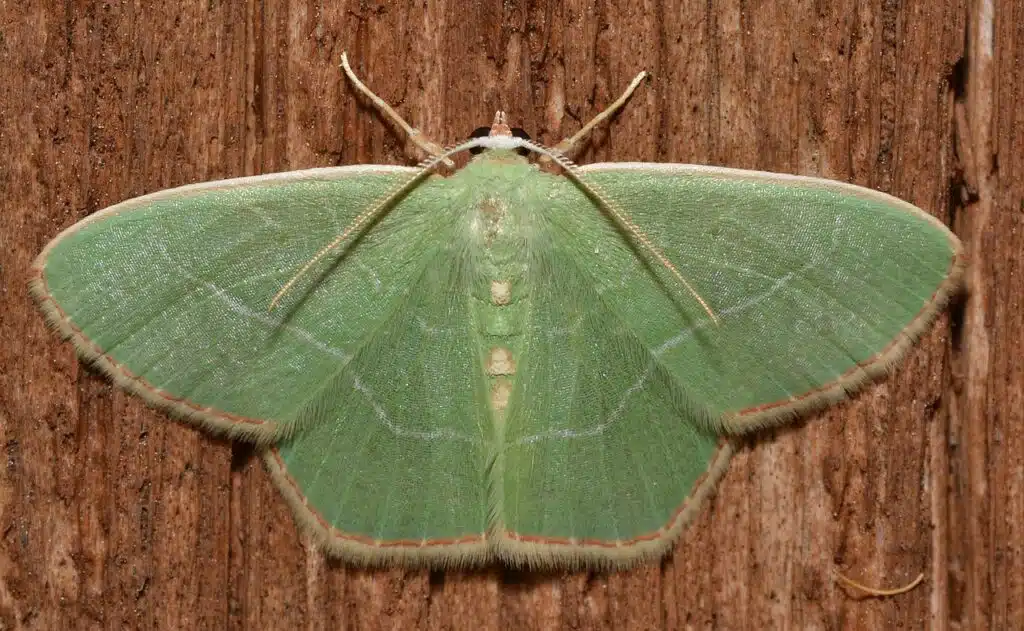
Red-fringed Emerald moth (Nemoria bistriaria) broods are seen every year. The species has an emerald green color.
White stripes are seen across its wings together with off-white overlays. The margins of the wings are dark red-brown and yellow.
The antennae of the species are mostly yellow.
You can find Red-fringed moths across North America. The area of the US it lives in dictates its broods and especially its flight season.
The season is shorter in the North and longer in the South.
Red-fringed Emerald moths are active from early spring to late October in Southern states.
The species is also seen in the Northern states, but later in the season with a shorter flight period. These moths appear in May and are only active until August here.
7. Green Leuconycta Moth
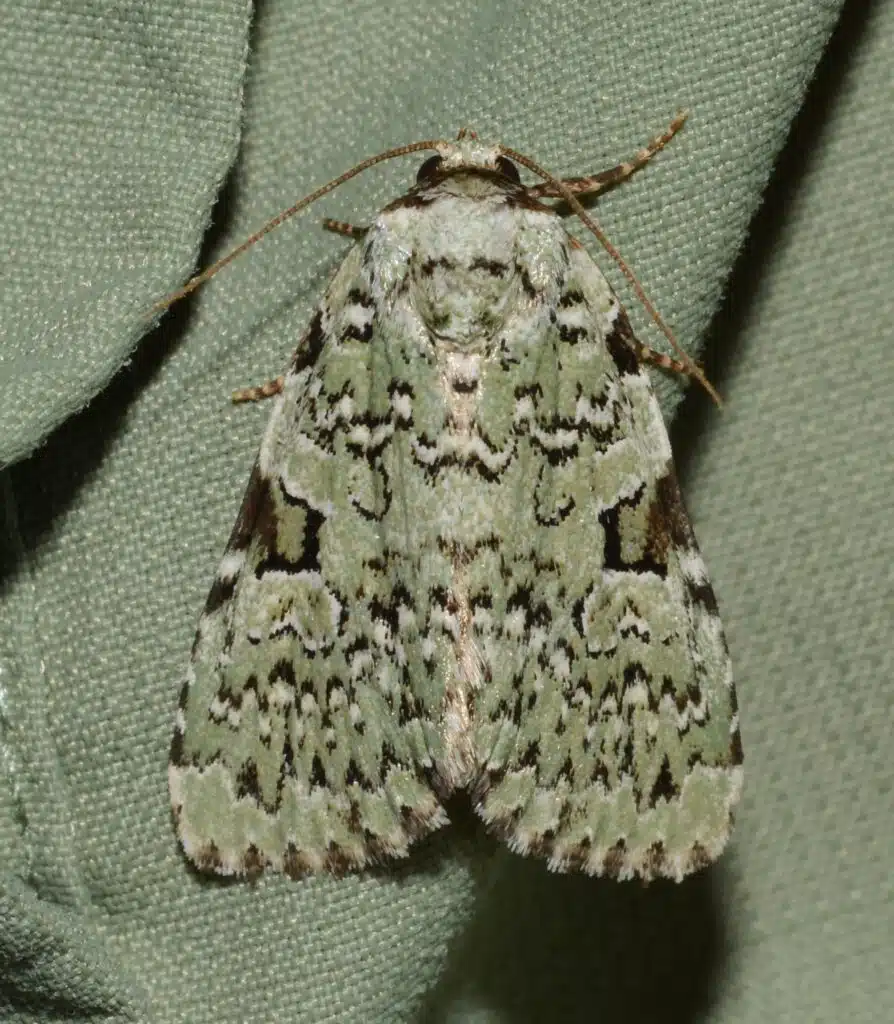
Green Leuconycta moths (Leuconycta diphteroides) are prevalent in Southern US territories and Eastern US territories.
This species has a green-gray base color with distinct patterns on the wings which makes for easy identification.
Its pale green base color also has gray nuances which means its wings aren’t vivid green.
Black, white, and even pale yellow are secondary colors from the patterns on the wings are made from.
Multiple white lines and marks with black borders are seen across the wings of the species.
The margins of its wings are either pale yellow or off-white to gray.
Its antennae are mostly black with off-white marks.
The most common place to see these moths is around the host plants they lay eggs on. Goldenrods are the main host plants of its caterpillars while asters are another common host.
8. Red-bordered Emerald

Red-bordered Emerald (Nemoria lixaria) is part of a group of green moths with red or red-brown margins.
These moths have pale green coloring with red-brown margins. Decorations on the wings can vary from males to females and from one region to another.
Red eyespots are sometimes seen on the body or the wings of the species.
Females of the species can show up to 7 red and white eyespots on the body.
The seasonality of the species depends on the weather. Red-bordered Emeralds in the South are active all year while those in the North are only active until temperatures start to drop in the fall.
9. Green Oak-Slug Moth
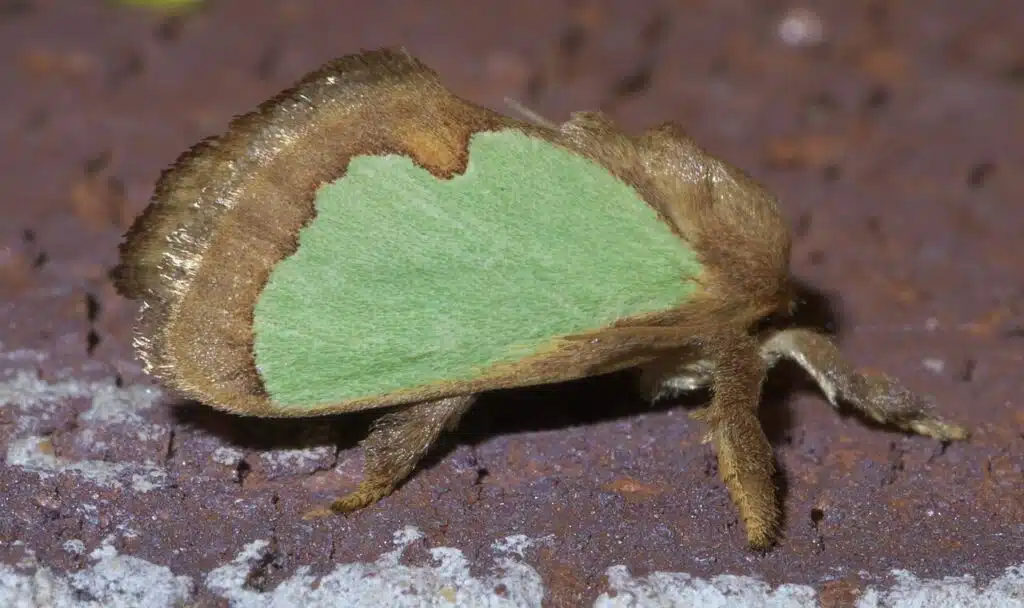
Green Oak-Slug moths (Euclea incisa) are mostly small and green. They are mainly known for mimicking techniques that aim to keep them safe from predators.
These moths are known for having green wings with wide brown margins which curl up into a cylindrical shape.
This act is believed to be an act of slug mimicry. The moths try to appear as slugs so that predators move along since slugs have bad taste.
Commonly seen on oaks as caterpillars, members of the species can have a detrimental role through their consumption of tree leaves.
The caterpillar of the species is identified by a base green color with brown central nuances and long hairs that protect it from birds and other predators.
10. Smaller Parasa Moth
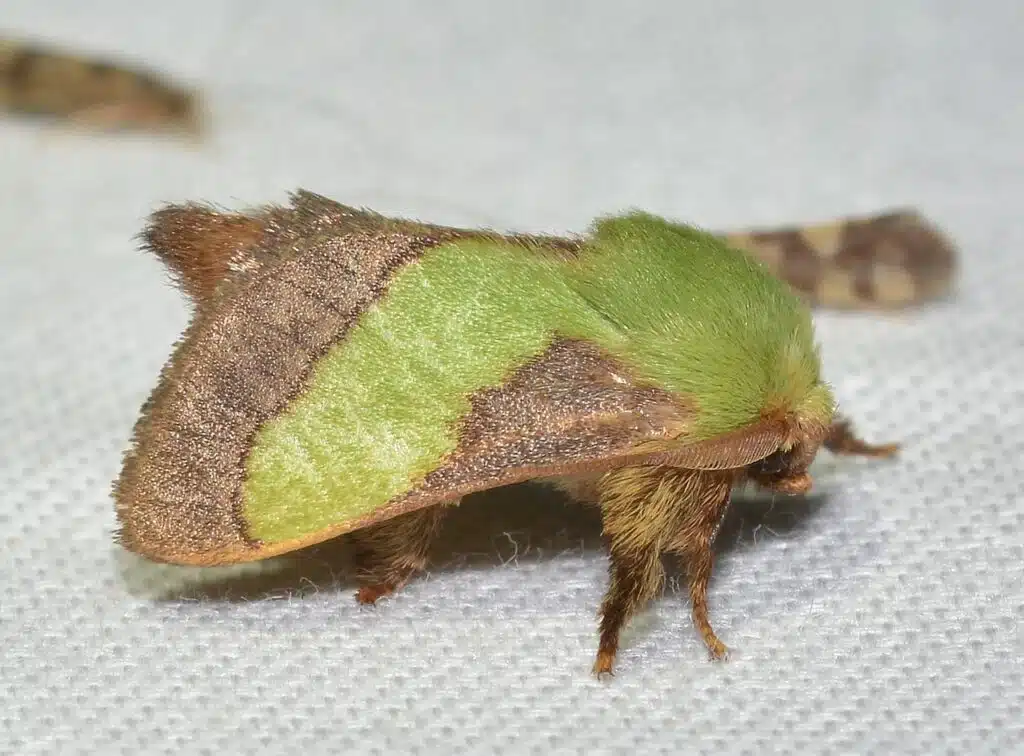
Smaller Parasa moths (Parasa chloris) are part of the same mimicking group as Green Oak-Slug moths.
These are types of moths that mimic slugs according to some theories, even if these theories aren’t agreed upon by everyone in the scientific community.
Smaller Paras moths have a base green color with wide brown margins. The head of the species is also green but covered in short hairs.
These moths keep their wings together in a rolled position.
This rolled position doesn’t immediately give away their species as many predators take them for slugs or other species and tend to move along.
As adult Smaller Parasa moths, caterpillar Smaller Parasas are also known to keep predators away. They have irritating hairs predators tend to stay away from.
11. Bicolored Chloraspilates Moth

This species of moths (Numia bicoloraria) gets its name from its dual coloring.
Its forewings are green while its hindwings are tan to brown.
Tiny brown and black marks and eyespots are seen across the margins of its forewings. The body of the moth has the same green-tan dual color as the wings.
The species is most common in the Southern US. It has a high presence in Southern Texas, Arizona, and New Mexico.
Bicolored Chloraspilates are also common in Southern California but to a lesser extent.
This species also lives in scarce populations in other areas such as Northern Texas and Oklahoma.
12. Showy Emerald
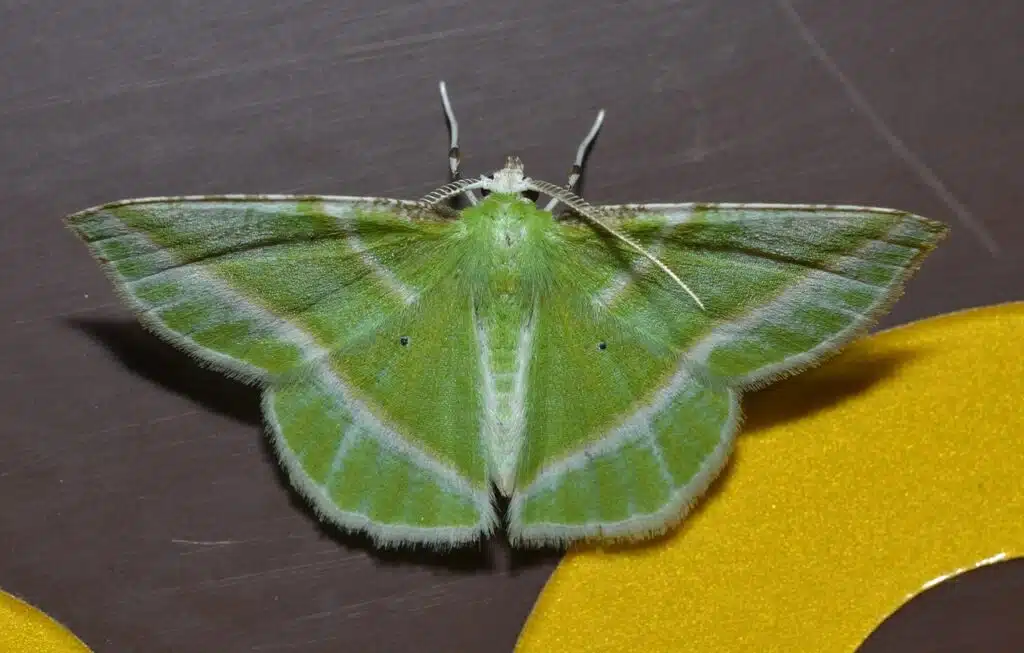
Showy Emeralds (Dichorda iridaria) are among the few green moths that are seen on various toxic plants across the Eastern and Southeastern US states.
This species has a slightly longer wingspan compared to other Emeralds. Its wingspan can reach 28mm.
Its wings have an emerald-green color with bright diagonal stripes.
Its ventral color is brown to light brown. The ventral side of its wings resembles dry leaves.
With an expanding habitat, this moth is believed to have a toxic taste to its few natural predators.
The Showy Emerald is seen around its host species of poison ivy. It’s also seen on various sumac-genus plants.
13. White-fringed Emerald
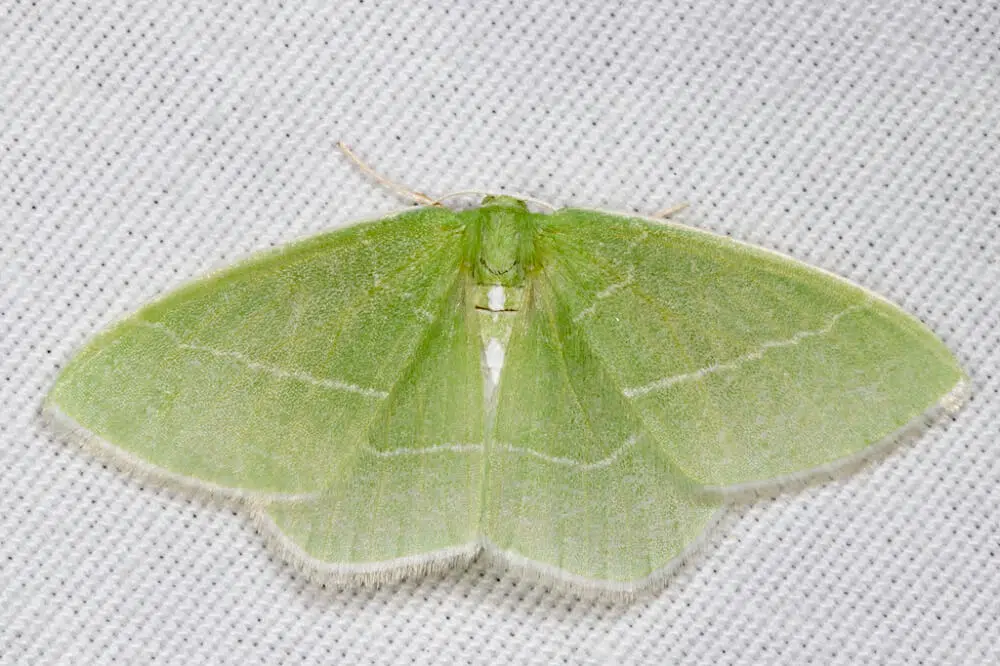
White-fringed Emeralds (Nemoria mimosaria) are North American native green moths.
The species resembles other Emerald moths with its green color, white stripes, and white to gray margins.
The wingspan of the species reaches 26mm.
You can see the moth across various woodlands as well as in territories with high elevations. The species is found in birch woodlands.
A considerable White-fringed Emerald presence is also signaled in balsam fir woodlands. To a lesser extent, these moths are also present outside woodlands on hos trees such as willow.
The moths are seen in high numbers across Nova Scotia and Alberta.
14. Laudable Arches
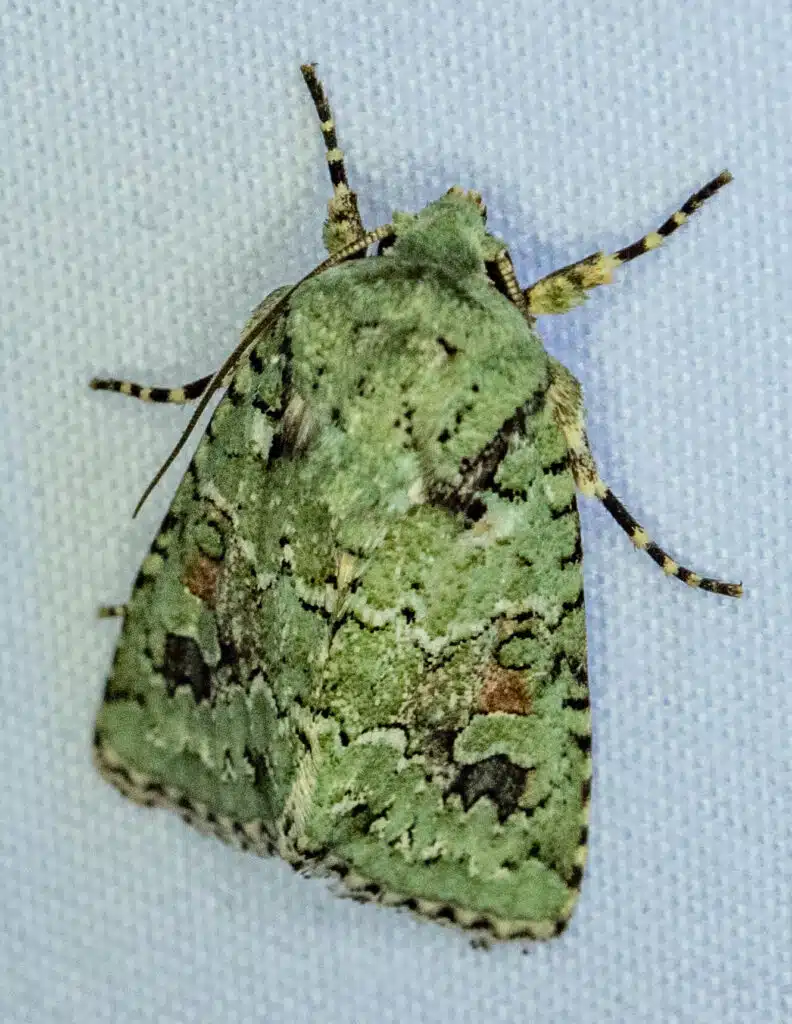
The Laudable Arches moths (Lacinipolia laudabilis) have a dark green and light green base color combination.
Dark grey sections are also visible on its wings.
This type of moth is native to the US. It can be found across various states with varying wingspans. At a minimum, the wingspan is around 20mm while the maximum recorded length is 28mm.
States such as Maryland, Georgia, and Florida are known to host a high number of Laudable Arches.
This species is also starting to emerge elsewhere in the world.
The species has made it to Europe either through accidental introduction or through migration as the species can migrate for food.
15. Dyar’s Lichen Moth
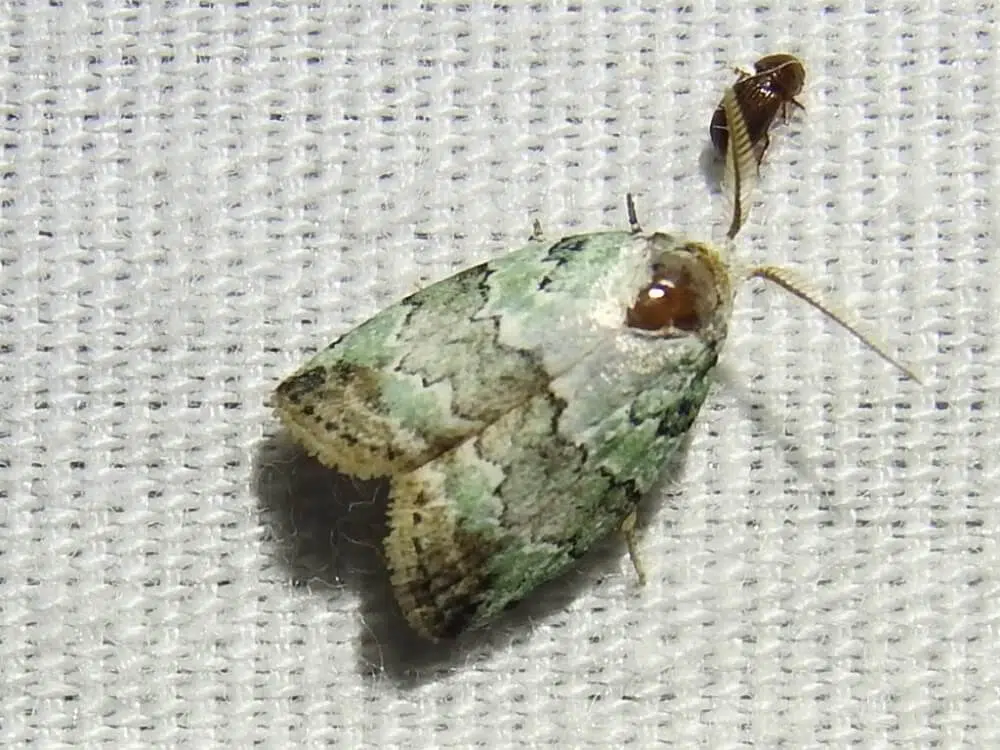
Dyar’s Luchen moth (Afrida ydatodes) is one of the species that are mostly white with a few white and green morphs.
The green morph has green forewings and brown marks across the tips of the wings. Small black dots are further distinguished across the margins of the wings.
White overlays are specific to the green morph of Dyar’s Lichen moth.
This species has a common presence in The Caribbean, Mexico, and Southern parts of the US.
It’s also one of the smallest green moths in North America by wingspan. Dyar’s Lichen moths has a maximum wingspan of 10mm.
16. White-barred Emerald
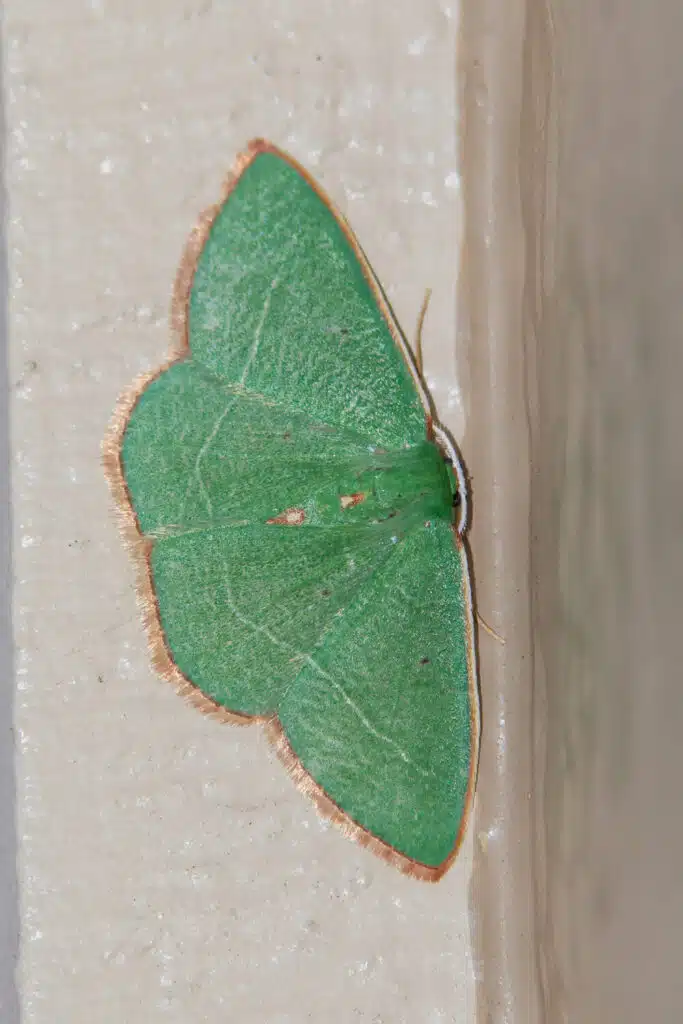
White-barred Emerald moths (Nemoria bifilata) are native to the US. These moths have a base emerald-green color with white lines and stripes as well as red or brown margins.
Small coloring differences are seen between the sexes. Males show a few small red eyespots on the lower body while the females have an off-white vertical band across the body.
Both males and females have the same green nuance.
White-barred Emeralds have a growing presence in the Southeastern US states including Florida. They are also found in Texas.
The species has also been reported around New York which is also believed to be the Northern limit of the White-barred Emerald.
17. Thin-lined Emerald
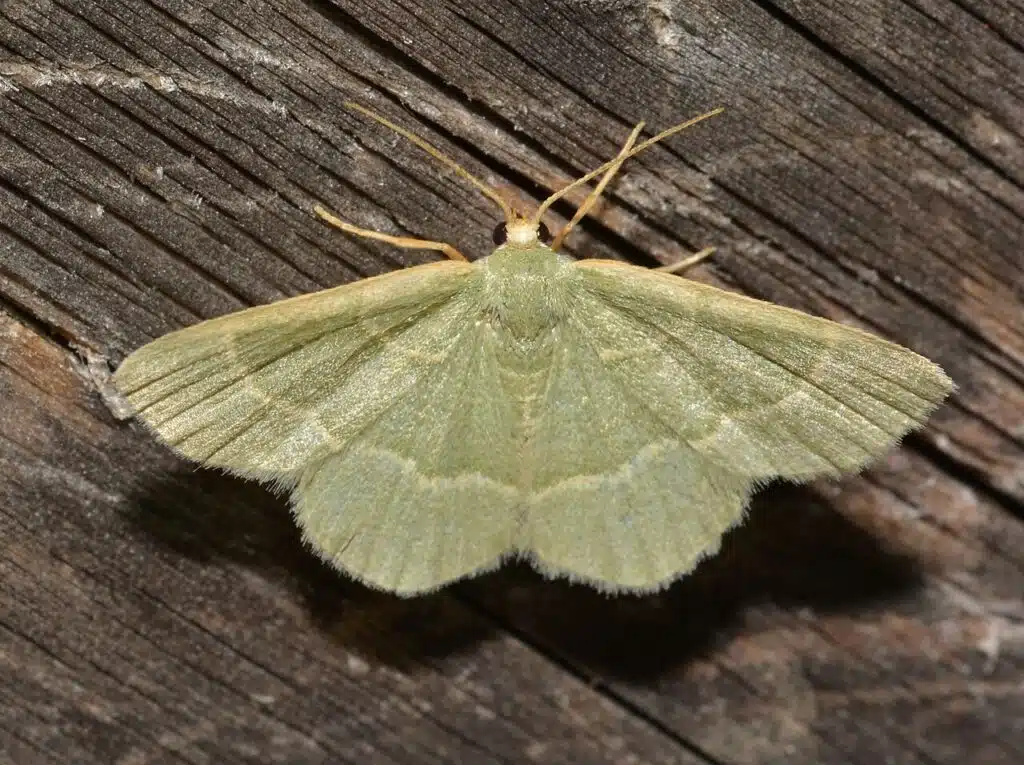
Thin-lined Emeralds (Chlorochlamys phyllinaria) are common across Southern US states including California.
Moths of this species also live in Central America down to Guatemala.
They have a congruent green color across the forewings and the hindwings with 2 white lines across that inspire their name.
Moths of the species are known to have wingspan differences between males and females. Males are slightly smaller with a maximum wingspan of 9mm. Females grow slightly larger with a wingspan of up to 10.5mm.
Some rare morphs of the species aren’t dominated by green coloring. Thin-lined Emeralds are also seen in a brown morph or a light brown morph.
18. Texas Emerald
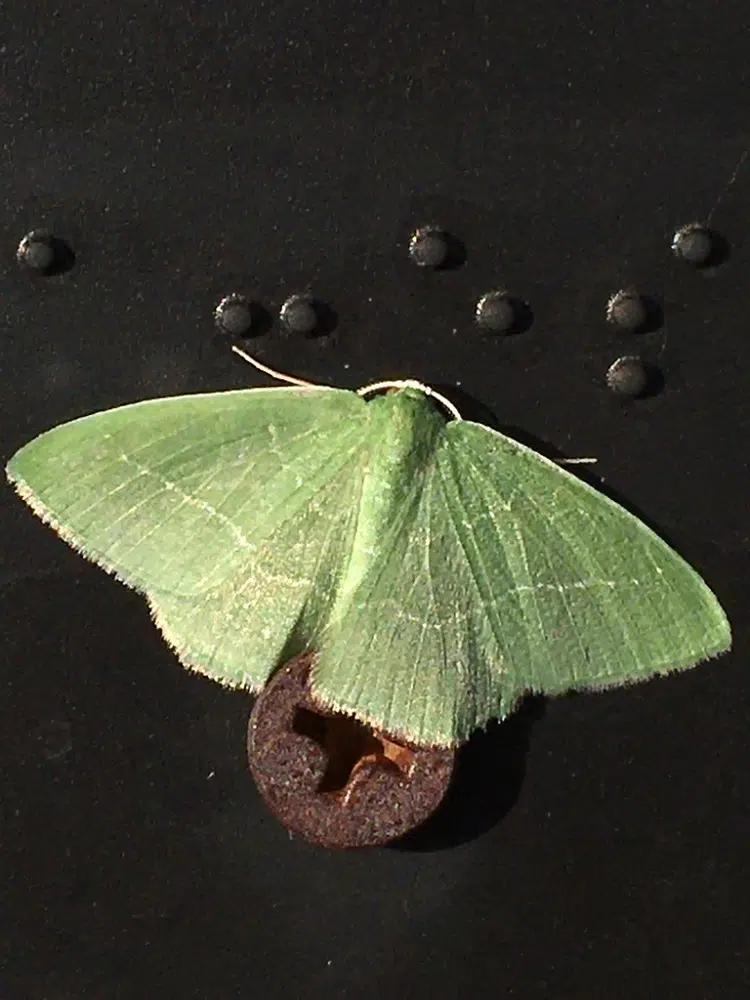
Native to North America and many parts of Texas, this (Nemoria zygotaria) is a species with dark green coloring.
Light green and even emerald green are common sights on North American green moths. But the Texas Emerald has dark green wings and a dark green body.
Fine white liens are further distinguished across its wings, as in other Emerald-genus moths.
Several vertical fine liens are distinguishable across its wings.
The species also has a dark green body. Brown to red marks is characteristic of the upper sections of its body while its lower body has white overlays.
19. Gaudy Sphinx
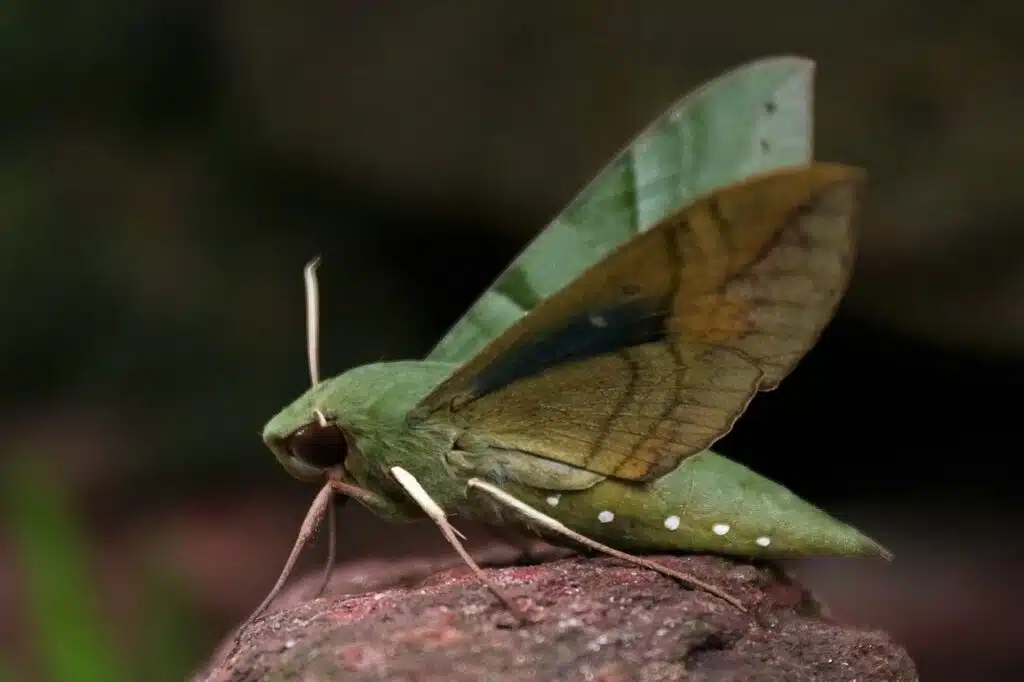
The Gaudy Sphinx (Eumorpha labruscae) is a rare green and blue moth. This species is mostly found across Florida, Texas, as well as in other central states.
Gaudy Sphinx is some of the largest green moths found in Eastern US states. Its wingspan commonly measures more than 4 inches.
The dark green nuance of the wings is combined with a blue section of the upper hindwings which also shows red coloration.
Its blue spots across the hindwings might be a camouflage interpretation of its common host plant, grape vines.
20. Pluto Sphinx

This mostly green moth (Xylophanes pluto) is native to the US and tropical parts of the world.
It’s only found in the extreme South of the US given it prefers to feed on tropical plants such as chiococca.
The moth has a base green color with gray overlays on the upper wings. Its hindwings are brown and yellow.
The body of the species is also green.
Small coloring differences on the dorsal are seen between males and females. The female of the species has a brown lower body and a green upper body as opposed to the fully green body of the male.
21. Cypress Emerald
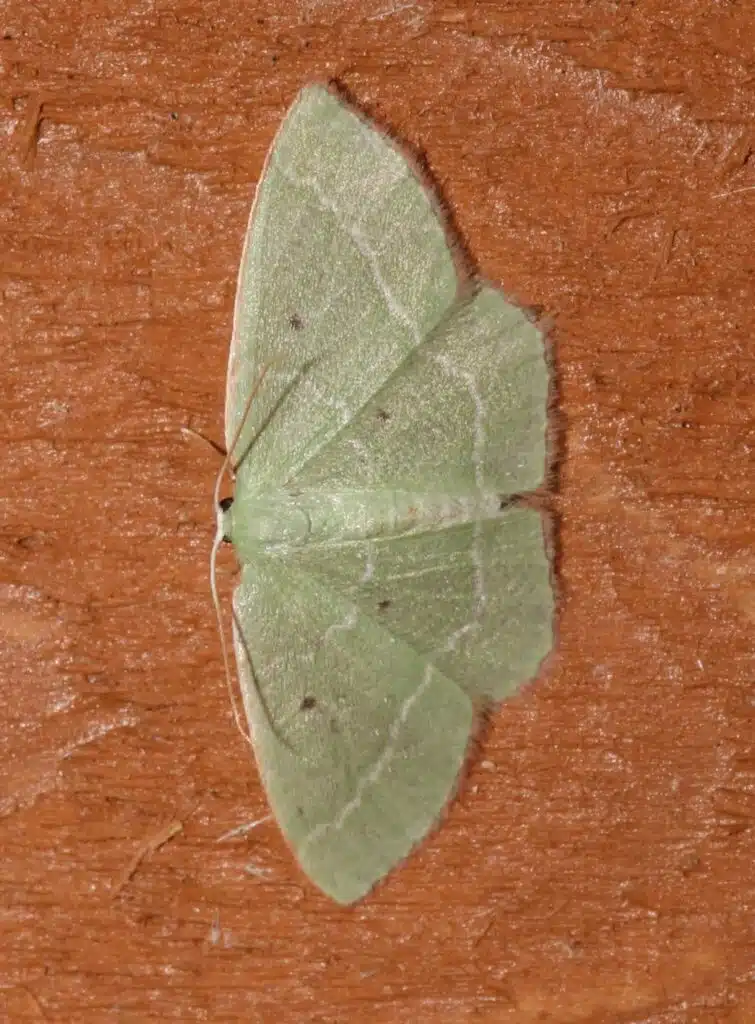
Cypress Emeralds (Nemoria elfa) are green moths common in woodlands and on higher elevation grounds.
These moths have a pale green dorsal color with a few white stripes across the wings. Males also show 4 tiny dark eyespots on the wings.
The ventral coloring of the species is dominated by a brown nuance. Its ventral side also shows white lines specific to the identification of its dorsal coloring.
22. Bad-wing Moth
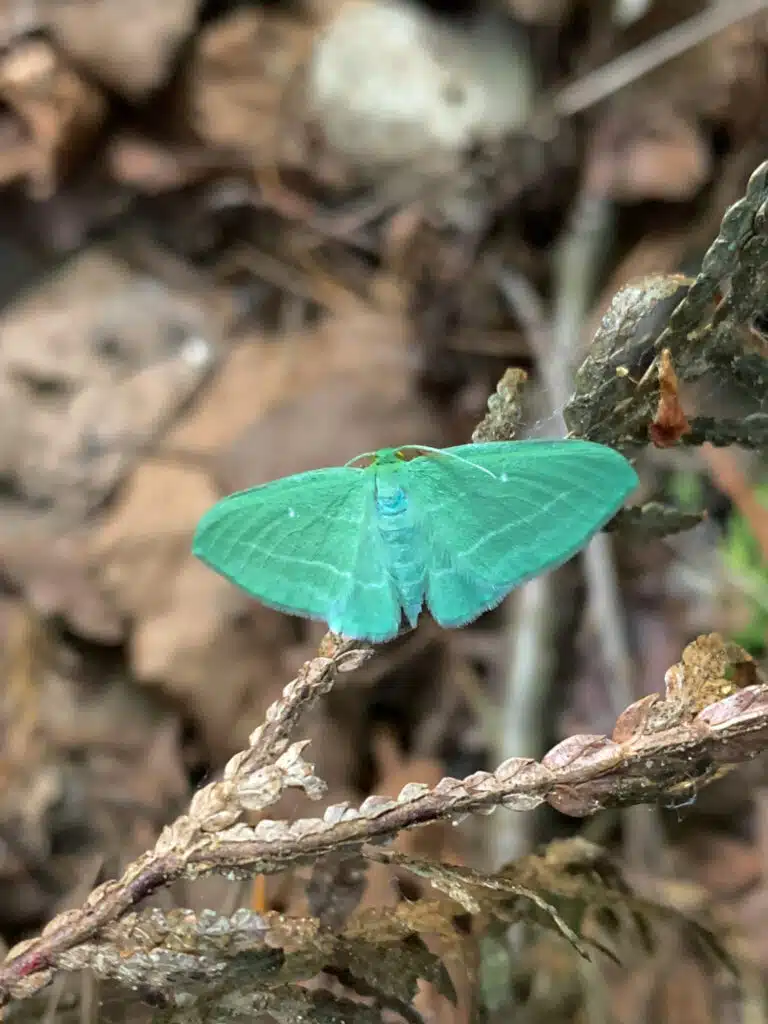
Bad-wing moths (Dyspteris abortivaria) are native to Eastern US states. This is a species where green coloring dominates both the dorsal and the ventral wings.
Even the legs of the species are green.
Its dorsal wings show a base green color with off-white lines across. These wings have the same green nuance as the body of the moth.
The shape of the moth resembles an inverted triangle. Its forewings are wider than its hindwings.
Vine grapes are one of the most common places to find Bad-wing moths. Caterpillars of the species feed on the leaves of the vines.
23. Olive Arta Moth
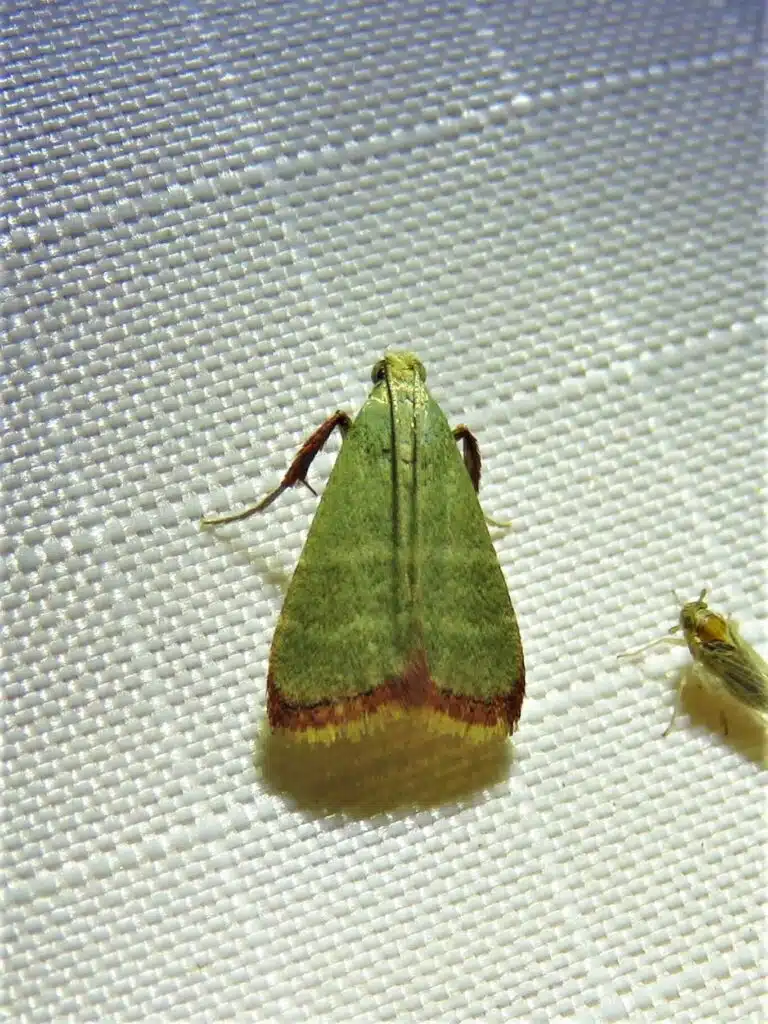
Olive Arta moths (Arta olivalis) are a species of small moths native to North America. Their presence is limited to Southern US territories as opposed to the widespread distribution of the Bad-wing moth.
This species comes in multiple morphs, most of which are green. Pale green and dark green morphs are the most common.
Brown ventral base color is specific to the Olive Arta moth.
Both its ventral and its dorsal wings show further white or off-white stripes across its wings.
24. Pacific Green Sphinx
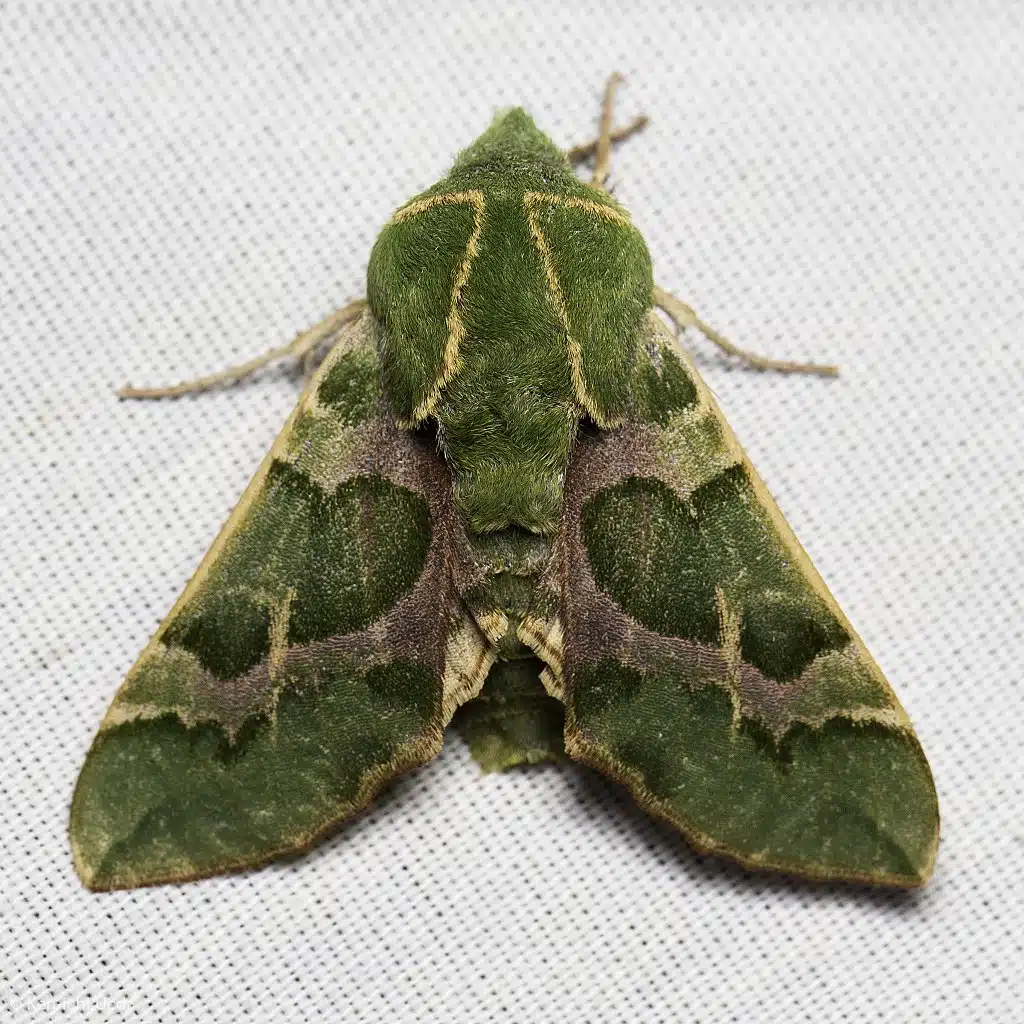
Pacific Green Sphinx (Proserpinus lucidus) get their name from their natural distribution across the West Coast.
These moths live in a habitat spreading from California to Washington.
Various shades of green are specific to this moth. Dark green and white green patterns are mostly visible across its upper wings.
A dark green body is also specific to this species. Its hairy body also shows gray, blue, and white hairs on the lower part.
The hindwings of the Pacific Green Sphinx are mostly tan, yellow, and brown.
This multicolored moth is one of the moths that fly from late winter to April.
25. Clark’s Sphinx
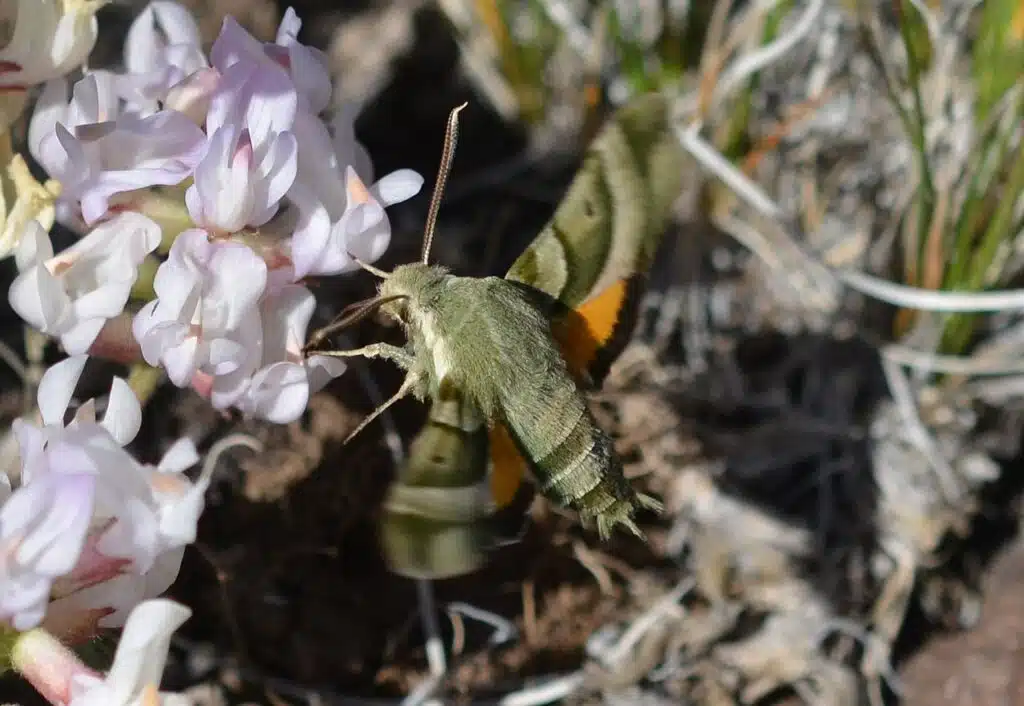
Clark’s Sphinx (Proserpinus clarkiae) is a moth native to Southwestern US territories that feed on nectar.
Sage plants are preferred for their nectar with this species.
Clark’s Sphinx has a partially green color. Its upper wings have brown, yellow, and black coloring while its body is mostly green.
The hindwings are orange with black margins.
26. Elder Moth
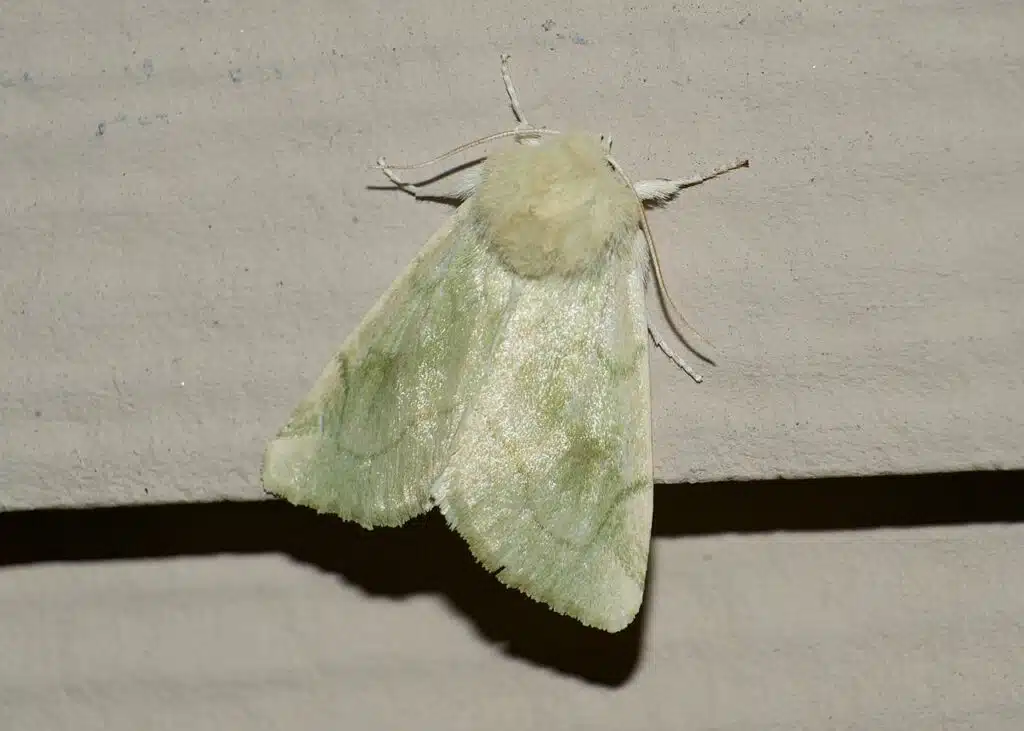
Elder moths (Zotheca tranquilla) are native to California. This species lives in riparian zones, areas close to the water with plenty of vegetation.
Its size is somewhat reduced compared to the size of other moths in the state.
White is the most common color the moth is seen. Green Elder moths are a rare sight but they are normally easy to identify given their reduced size.
This species is also found in other areas of the US and Canada, in smaller populations. It can be found on the Western US and Canadian coasts.
27. Comstock’s Sallow
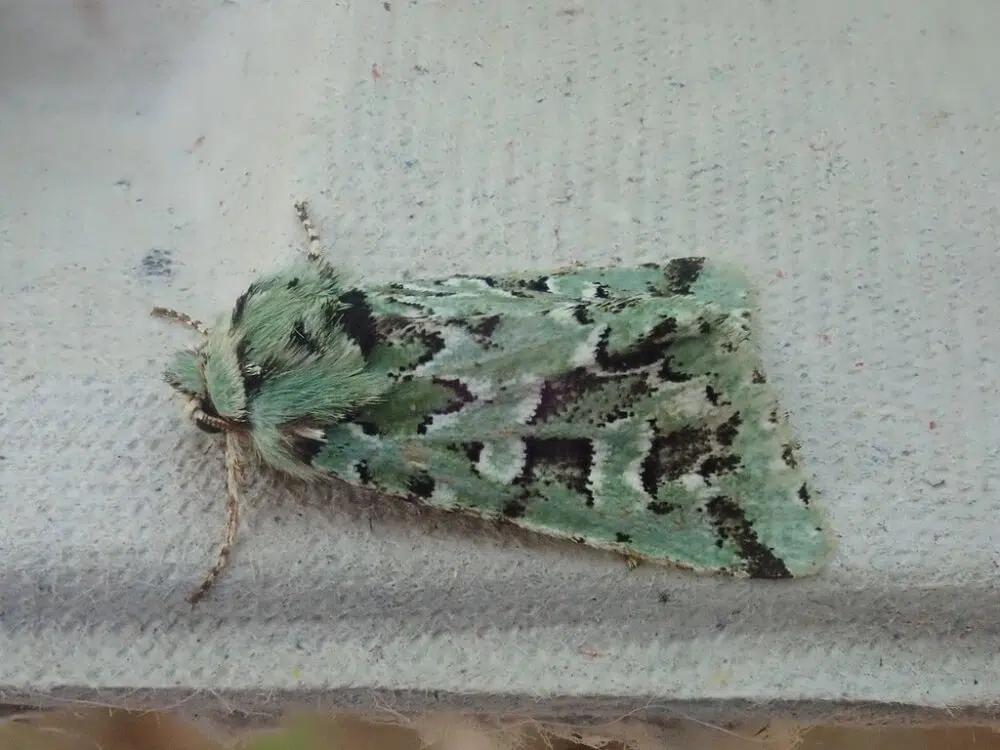
Feeding on pine, Comstock’s Sallow (Feralia comstocki) is a moth species native to Northeastern parts of North America.
Found both in the US and in Canada, this species has different green and dark green coloring.
The moth has black and white marks across its margins.
This species also has green marks on its dark legs.
Comstock’s Sallow has a varying wingspan that never measures more than 35mm.
Its flight season is limited by the short and cool summers of the North. This is why Comstock’s Sallow is only active until June each year.
28. Dimorphic Macalla Moth
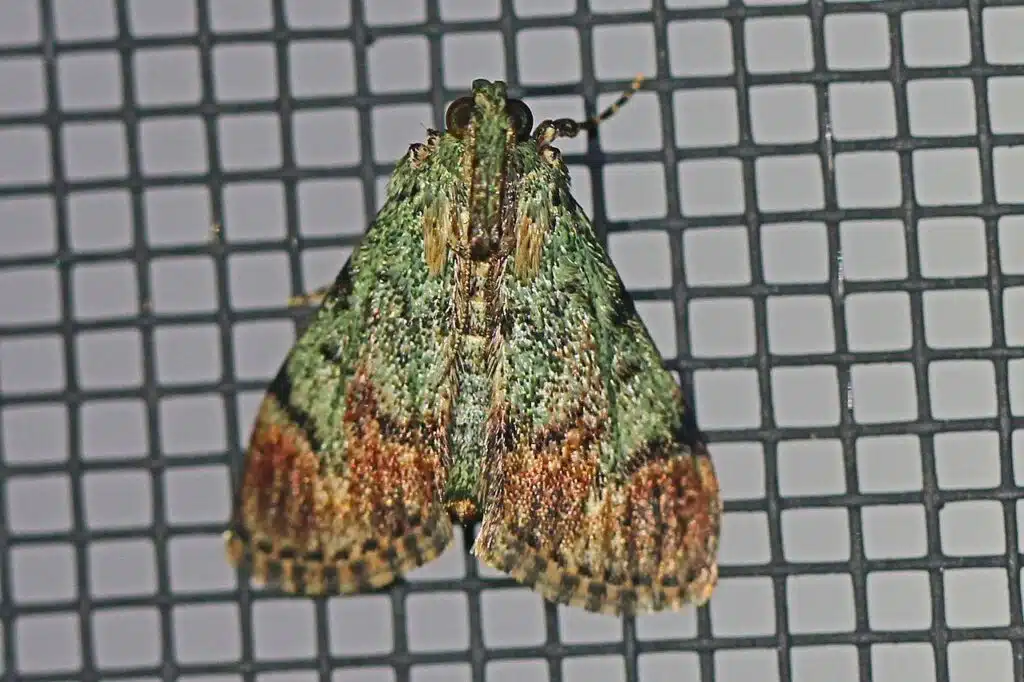
Dimorphic Macalla moths (Epipaschia superatalis) have a dark color with green coloring across the upper wings.
Black marks and black spots are seen on its upper wings.
The hindwings of the species are mostly brown and gray. Black margins are seen across its hindwings.
Some morphs of the Dimorphic Macalla moth are also known for having both green upper wings and green hindwings.
Caterpillars of the species are also known to either have a yellow and black or a green and black color combination.
These moths have a widespread distribution on the Eastern side of the US. They are found in New York, Missouri, Texas, Florida, and all other states in-between.
Further Reading: